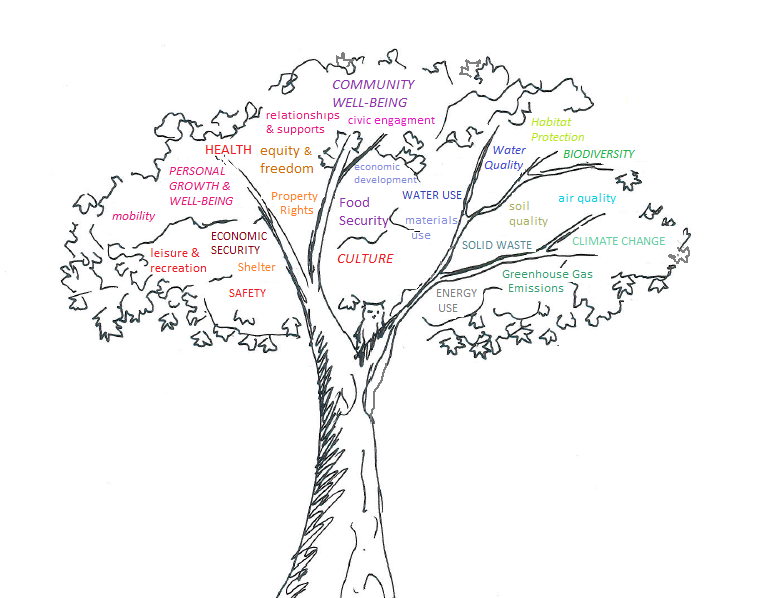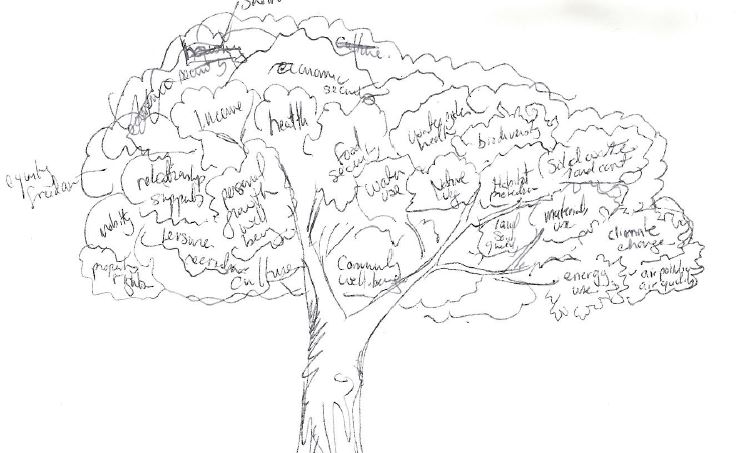
Many years ago, I sketched out a visualization of how social and environmental impacts interelate as a living tree. It helped me think about how diverse impacts can be closely connected, especially in how individual well-being connects with community well-being and the environment. People I showed it to liked how it made them think about impacts that they wouldn't otherwise associate with their work. Today I have made that sketch into a more legible drawing using Paint.! Not the most high end graphic design program, I know, but it no longer resides in a folder near my desk. Each impact area also has many dimensions to explore which are already part of the Impact Mapping Worksheet and are listed below.
How to use the tree?
Beyond imagining sitting under the tree on a lovely summer's afternoon, you can scan the tree illustration to find the words that you identify with your impact. Look at the related branches to identify other facets that relate. For instance, if you know that you are contributing to the personal growth and well-being of employees that you hire, consider how you may also be contributing to (or doing things to support): building relationships, health, mobility and economic security. Click here to download the tree and impact dimensions.
Impact Area | Impact Dimensions | |
Air Quality | - decrease in air pollutants, smog, acid rain | |
Biodiversity/ Habitat protection | - health of biological systems - use of native vegetation | |
Civic engagement | -level of citizen involvement in civic life - political and non-political. | |
Climate Change | - reducing the possibility of significant, long-lasting changes in the climate of our planet. - adapting to changes in the climate | |
Community Well-being | - encompass all other parts of the tree relating to the healthy functioning of individuals, communities and the natural world. | |
Culture | -shared traditions and values -cultural identity and preservation. | |
Economic Development | -investment | |
Economic security | financial resources necessary to participate fully and with dignity in community activities | |
Energy use | -reduction in the amount of energy used | |
Equity and freedom | -diversity | |
Food security | -quality and sustainability of the food supply | |
Greenhouse gas emissions | --reduction in GHG gases by cutting emissions or improving sinks. | |
Health | -physical and mental health -health conditions | |
Leisure and Recreation | -free time | |
Materials use | -decrease in the amount of materials used (per good/ absolute) | |
Mobility | -the ability to move in the community -barrier-free transportation | |
Personal Growth and Well-being | -emotional well being | |
Property rights | -individual or community ownership and possession of land -cultural and intellectual property -indigenous entitlements | |
Relationships and Supports | -personal relationships | |
Safety | -incidence of crime | |
Shelter | access to secure and affordable housing | |
Soil quality | - improvements in soil quality | |
Waste | reduction in solid waste to landfill through recycling, and reuse. | |
Water quality | -limiting water pollution - improvement in water quality | |
Water Use | -decrease in water use for human consumption and manufacturing -using water in a way that doesn’t compromise ecosystem functioning of the water system | |
My sketch, circa 2008

